You don’t need a sprawling garden to enjoy the benefits of indoor plants; even your compact bathroom can become a thriving green oasis. These eight specialized plants have adapted to survive, and even flourish, in the unique conditions of small bathroom spaces: low light, high humidity, and limited surface area. From air-purifying champions to low-maintenance survivors, each plant offers distinct advantages that’ll transform your bathroom into a refreshing sanctuary.
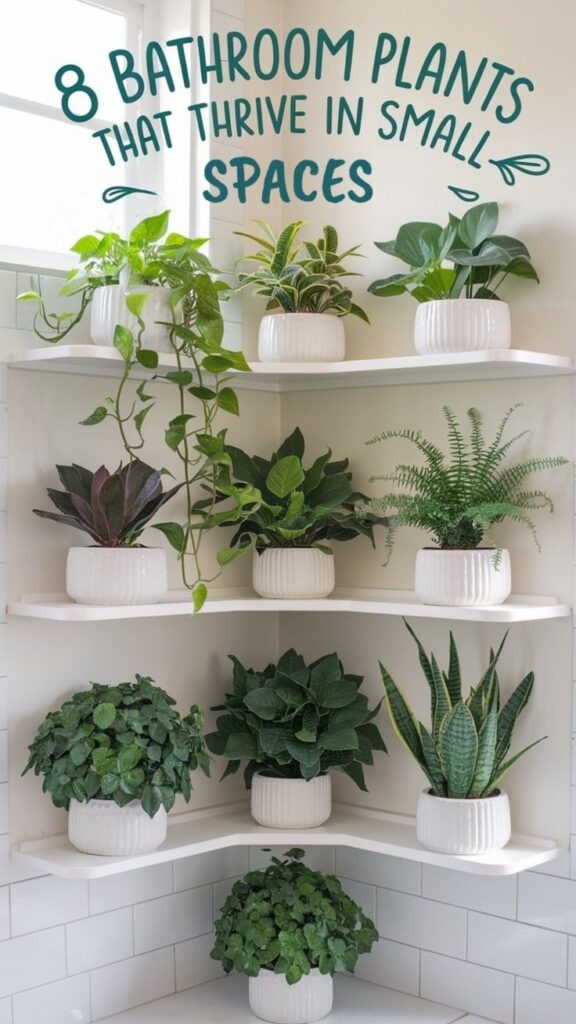
Contents
- 1 Snake Plant (Sansevieria): The Ultimate Low-Light Survivor
- 2 Pothos: The Versatile Hanging Wonder
- 3 Peace Lily: An Air-Purifying Champion
- 4 Spider Plant: Perfect for Shower-Side Hanging
- 5 Bamboo: Lucky and Low-Maintenance
- 6 Boston Fern: The Humidity Lover
- 7 ZZ Plant: The Ultimate Bathroom Warrior
- 8 Air Plants: Space-Saving Bathroom Decor
Snake Plant (Sansevieria): The Ultimate Low-Light Survivor
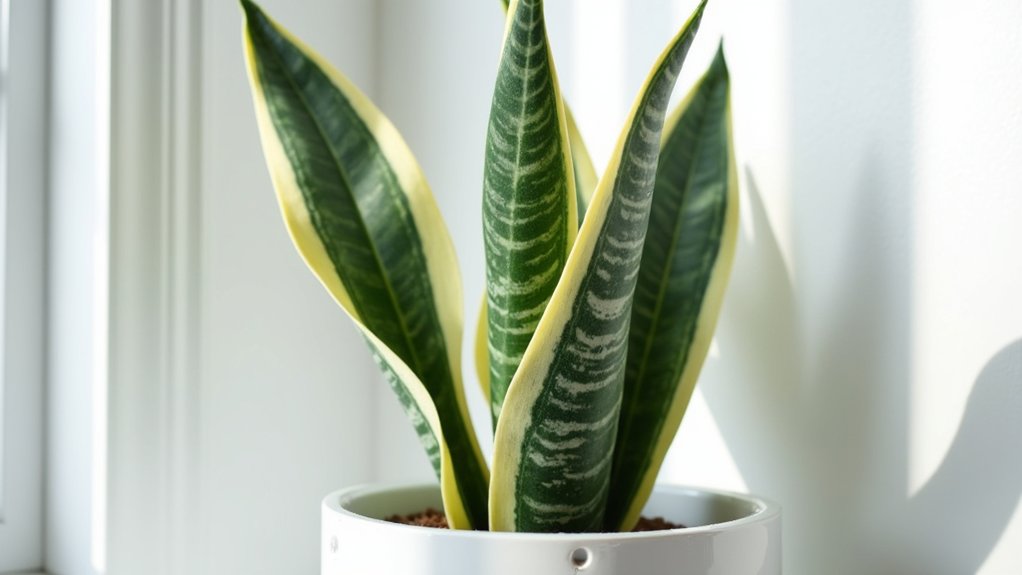
The Snake Plant, with its striking sword-like leaves growing in upright rosettes, stands as one of the most adaptable bathroom plants available. Its distinctive vertical growth pattern features stiff, variegated leaves in shades of green, often with yellow edges, making it an architectural statement piece even in tight spaces.
This hardy succulent can grow anywhere from 6 inches to several feet tall, depending on the variety, and its air-purifying qualities make it particularly valuable in bathroom environments.
Growing Conditions:
- Light: Tolerates low light but thrives in indirect bright light
- Water: Allow soil to dry completely between waterings
- Humidity: Adapts to any humidity level
- Temperature: Comfortable in normal indoor temperatures (60-85°F)
- Soil: Well-draining potting mix
- Container: Pot with drainage holes to prevent root rot
To maintain a healthy Snake Plant, regularly dust the leaves with a damp cloth to keep them looking pristine and maintain their air-purifying efficiency.
Inspect the plant monthly for signs of pests, particularly mealybugs, which can occasionally appear in bathroom conditions. While the plant is highly resistant to most problems, avoid overwatering by checking the soil moisture level with your finger before adding water, and trim any yellow or brown leaves at the base to maintain its neat appearance.
Pothos: The Versatile Hanging Wonder
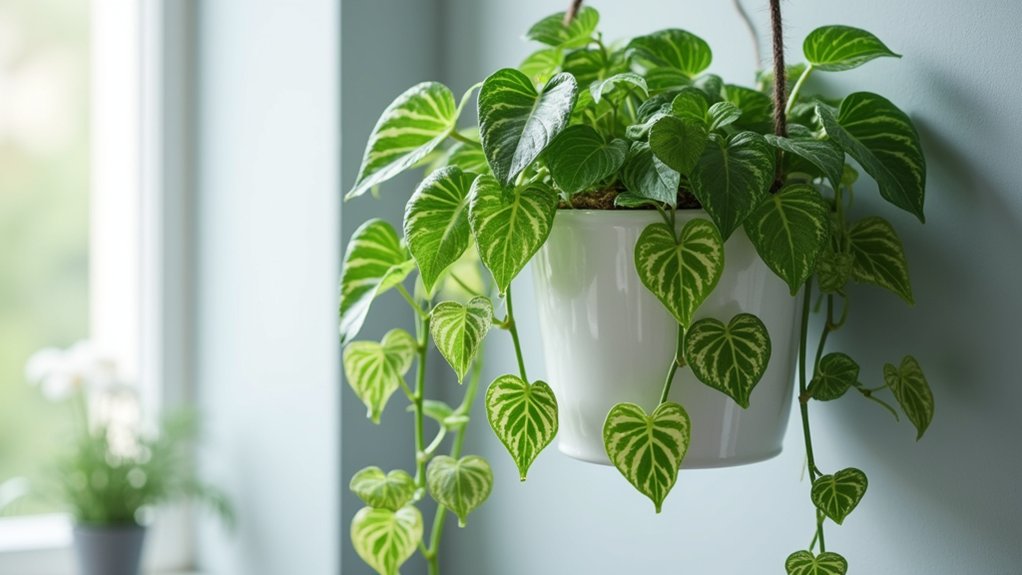
Pothos (Epipremnum aureum) is a trailing vine with heart-shaped leaves that can transform any bathroom into a lush oasis. This adaptable plant comes in various varieties, featuring different patterns of green, yellow, or white variegation on its glossy foliage.
As a natural climber or cascading plant, pothos can be displayed in hanging baskets, on shelves, or trained to climb bathroom walls, making it perfect for maximizing vertical space in small bathrooms.
- Light: Tolerates low to moderate indirect light; avoid direct sunlight
- Water: Allow top 1-2 inches of soil to dry between waterings
- Soil: Well-draining potting mix
- Humidity: Thrives in bathroom humidity levels
- Temperature: Comfortable in normal indoor temperatures (60-80°F)
- Container: Any pot with drainage holes, ideal for hanging baskets
Regular pruning helps maintain a fuller, bushier appearance and prevents the vines from becoming too leggy.
Remove any yellowing or damaged leaves promptly to maintain plant health and appearance. To encourage fuller growth, pinch off growing tips periodically, and wipe leaves occasionally with a damp cloth to remove dust and maintain their natural shine.
These cuttings can easily be propagated in water to create new plants, making pothos an excellent choice for expanding your bathroom greenery collection.
Peace Lily: An Air-Purifying Champion
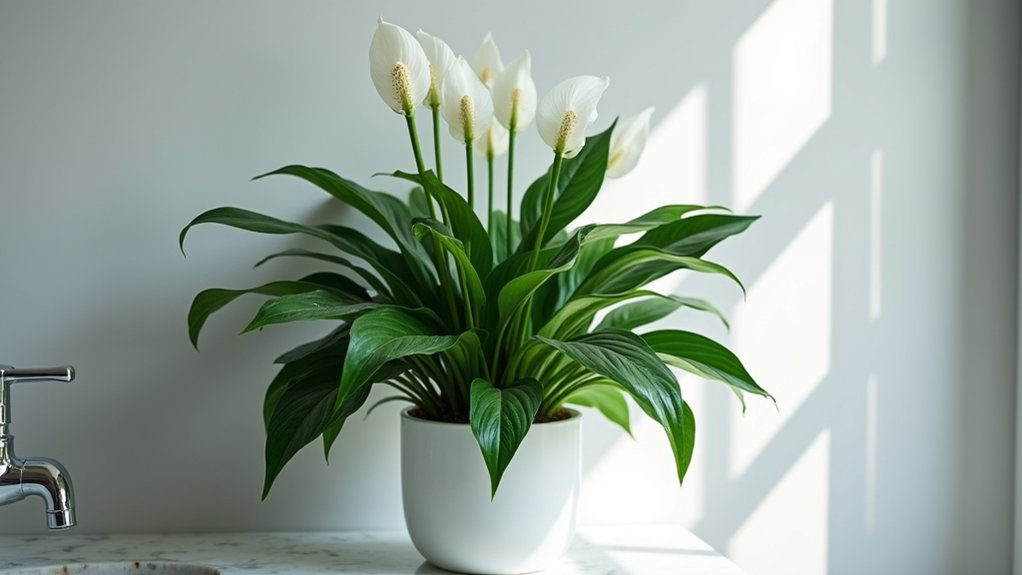
The Peace Lily (Spathiphyllum) is a striking tropical plant known for its glossy, dark green leaves and distinctive white flowers that bloom throughout the year. Beyond its elegant appearance, this plant has earned recognition as one of nature’s most effective air purifiers, capable of removing common household toxins like benzene, formaldehyde, and carbon monoxide from the air.
The plant’s sophisticated look comes from its lance-shaped foliage that grows in clumps, complemented by long-lasting white spathes that rise above the leaves on slender stalks.
- Light: Thrives in medium to low indirect light; avoid direct sunlight
- Water: Keep soil consistently moist but not waterlogged; water when top inch of soil feels dry
- Humidity: Prefers high humidity levels of 50% or more
- Temperature: Maintains best growth between 65-80°F (18-27°C)
- Soil: Well-draining potting mix rich in organic matter
- Fertilizer: Feed with balanced liquid fertilizer every 6-8 weeks during growing season
Regular grooming is essential for maintaining a healthy Peace Lily. Remove yellowed or damaged leaves at the base of the stem, and trim spent flowers once they begin to turn green.
Dust the leaves periodically with a damp cloth to keep their pores clear for optimal air purification and prevent spider mites. If the plant becomes rootbound, divide and repot it in spring, which will also help maintain its size and promote new growth.
Watch for brown leaf tips, which often indicate either over-fertilization or mineral buildup from tap water – using filtered water can help prevent this issue.
Spider Plant: Perfect for Shower-Side Hanging
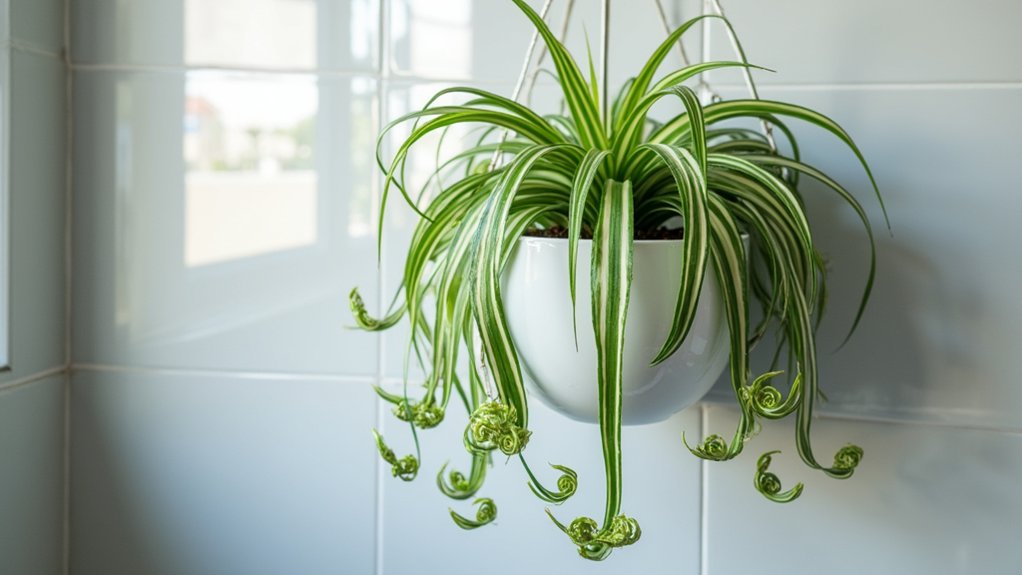
Spider plants (Chlorophytum comosum) are ideal bathroom companions with their graceful, arching leaves that cascade from hanging baskets.
These adaptable plants feature long, narrow leaves with distinctive white or cream stripes, creating a striking waterfall effect. Baby plantlets, known as spiderettes, dangle from long stems, adding visual interest and earning the plant its common name.
- Light: Bright indirect light; can tolerate moderate to low light conditions
- Water: Keep soil consistently moist but not waterlogged
- Humidity: Thrives in high humidity environments
- Temperature: Comfortable in average room temperatures (60-75°F)
- Soil: Well-draining potting mix
- Container: Hanging basket or pot with drainage holes
Regular grooming keeps spider plants looking their best in bathroom settings.
Remove any yellowed or brown leaves promptly, and trim off spiderettes if they become too numerous or leggy.
Rotate the plant occasionally to ensure even growth, and dust the leaves periodically to maintain their photosynthetic efficiency.
When the plant becomes root-bound or overgrown, divide it into smaller sections and repot in fresh soil to rejuvenate growth.
Bamboo: Lucky and Low-Maintenance

Lucky bamboo, despite its name, is actually a member of the Dracaena family and not true bamboo. Its elegant, upright stalks can be trained into various shapes and arrangements, making it a versatile choice for small bathrooms. The plant’s slender green stems and narrow leaves create a minimalist, Asian-inspired aesthetic, while its reputation for bringing good fortune makes it a popular choice for feng shui enthusiasts.
- Light: Thrives in moderate to low indirect light; avoid direct sunlight
- Water: Can grow in water alone or well-draining soil; keep water level consistent if growing in water
- Temperature: Prefers warm environments between 65-90°F
- Humidity: Enjoys high humidity levels, making it perfect for bathrooms
- Fertilizer: Feed with diluted liquid fertilizer every 2-3 months
- Container: Use a container with drainage if planting in soil; for water-grown plants, change water weekly
To maintain lucky bamboo‘s health, regularly trim yellowing leaves and remove any algae that forms in water-based containers.
Rotate the container periodically to ensure even growth, as stems will naturally grow toward light sources. When stems become too tall, they can be pruned to desired height, and the cuttings can be propagated in water to create new plants.
If dark spots appear on the stems or leaves turn yellow, move the plant slightly farther from light sources and ensure water quality remains clean.
Boston Fern: The Humidity Lover
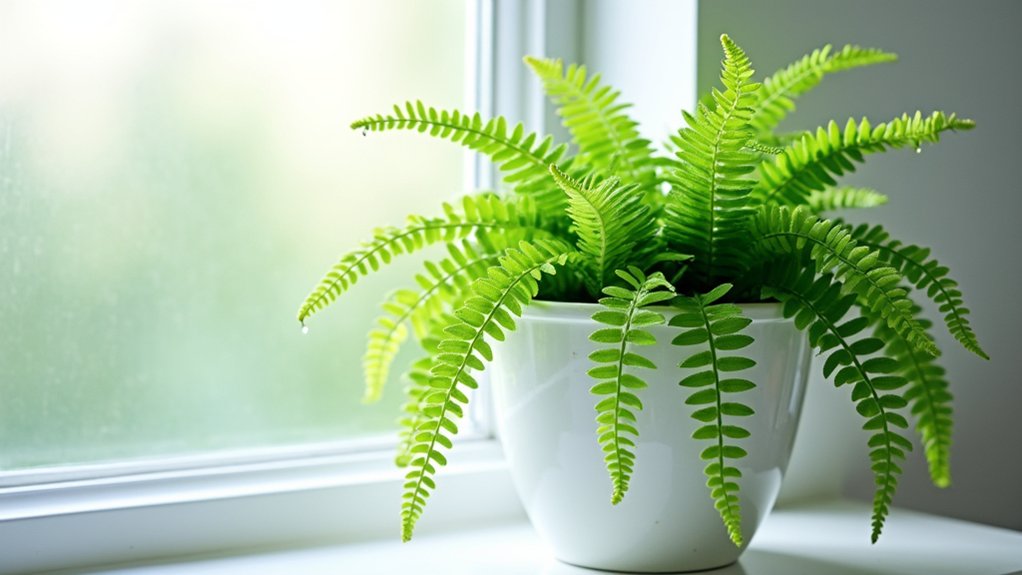
The Boston Fern (Nephrolepis exaltata) is a classic bathroom plant featuring graceful, arching fronds with delicate, feather-like leaves that can grow up to 3 feet long.
Its lush, bright green foliage creates a cascading effect, making it particularly attractive in hanging baskets or on elevated surfaces. This tropical plant’s natural ability to thrive in humid environments makes it perfectly suited for bathroom settings, where it can also help purify the air and add a touch of natural elegance.
Growing Conditions:
- Light: Bright, indirect light; avoid direct sunlight
- Humidity: High humidity (50-80%)
- Temperature: 60-75°F (16-24°C)
- Water: Keep soil consistently moist but not waterlogged
- Soil: Well-draining, rich potting mix
- Container: Use pots with drainage holes
Regular grooming is essential for maintaining a healthy Boston Fern.
Remove any yellow, brown, or dead fronds at their base to encourage new growth and maintain the plant’s shape. Mist the leaves frequently if bathroom humidity isn’t sufficient, and rotate the plant quarterly to ensure even growth.
During the growing season, feed with a balanced, water-soluble fertilizer every 4-6 weeks, but reduce feeding during winter months when growth naturally slows.
ZZ Plant: The Ultimate Bathroom Warrior
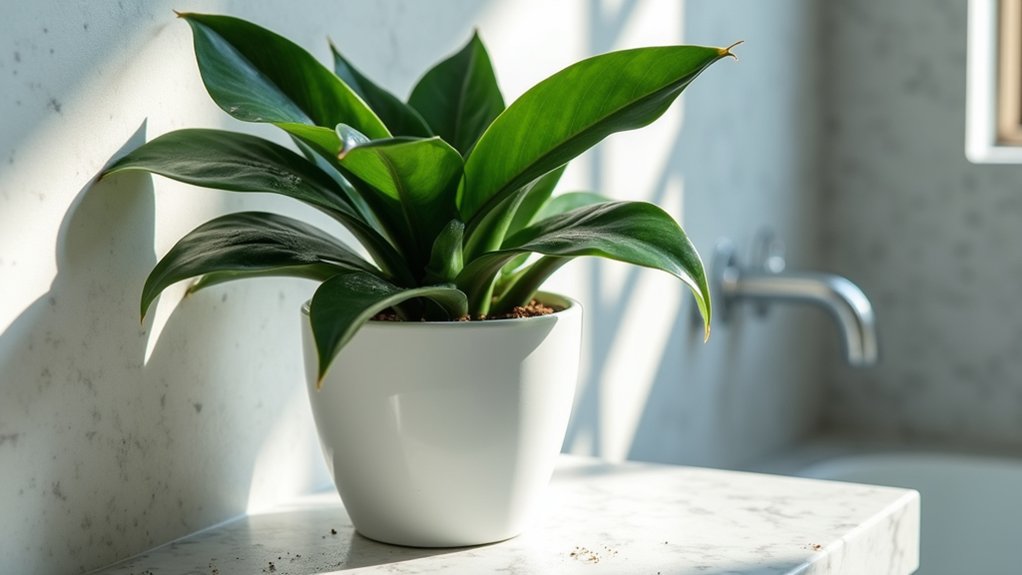
The ZZ Plant (Zamioculcas zamiifolia) stands as one of the most resilient bathroom-friendly houseplants, featuring glossy, dark green leaves arranged in a feather-like pattern along thick stems. This architectural beauty grows in an upright fashion, reaching heights between 2-3 feet, making it perfect for bathroom corners or countertops.
Its succulent-like characteristics allow it to store water in its thick rhizomes, enabling exceptional drought tolerance and survival in less-than-ideal conditions.
- Light: Tolerates low to moderate indirect light; can survive in artificial lighting
- Water: Allow soil to dry between waterings; water every 2-3 weeks
- Humidity: Adapts to any humidity level
- Temperature: Thrives in 65-75°F (18-24°C)
- Soil: Well-draining potting mix; prefers slightly acidic soil
- Container: Pot with drainage holes to prevent root rot
To maintain a healthy ZZ Plant, dust the leaves monthly with a damp cloth to maintain their shine and ensure optimal photosynthesis.
Prune yellowing or dead stems at the base, and check rhizomes occasionally for signs of rot or overcrowding. While the plant rarely needs fertilizer, applying a balanced houseplant fertilizer at quarter strength once during the growing season can support healthy growth.
Watch for signs of overwatering, which is the most common issue with ZZ Plants, and adjust watering frequency accordingly.
Air Plants: Space-Saving Bathroom Decor
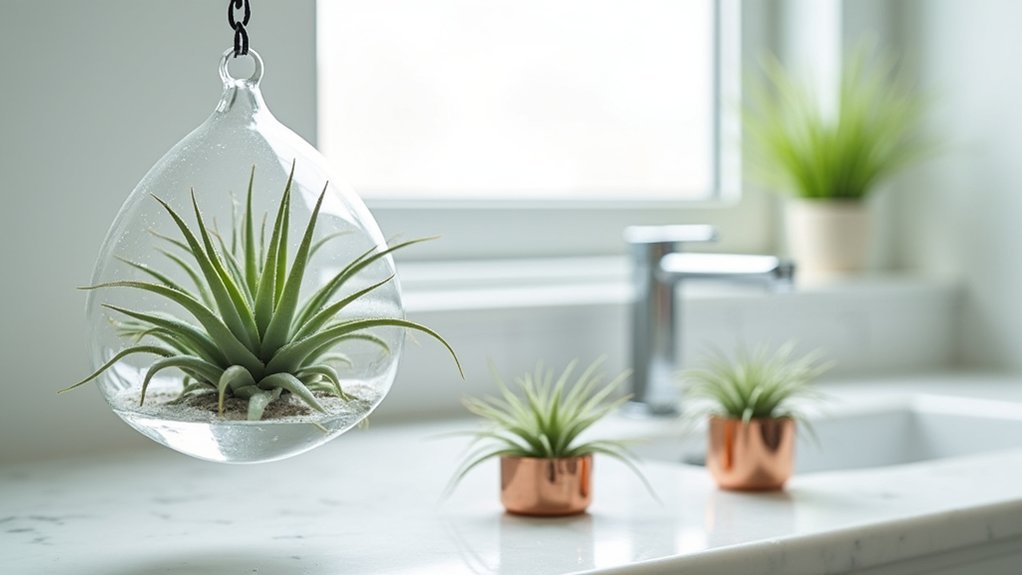
Air plants (Tillandsia) are unique, soil-free plants that make perfect additions to tiny bathrooms due to their compact size and versatile mounting options.
These otherworldly-looking plants feature silvery-green leaves arranged in rosette patterns, with some varieties producing vibrant blooms in pink, purple, or red. Their ability to grow without soil allows them to be displayed in wall-mounted holders, hanging glass terrariums, or simply perched on bathroom shelves, making them ideal for maximizing limited space.
Light Requirements:
- Bright, indirect light
- Avoid direct sunlight which can burn leaves
- At least 3-4 feet from windows
- Can tolerate artificial bathroom lighting
Water Needs:
- Mist 2-3 times per week
- Soak in room temperature water for 20-30 minutes weekly
- Shake off excess water after soaking
- Higher humidity levels (50-60%) preferred
Maintaining air plants requires attention to air circulation and regular grooming.
Remove any brown or dead leaves by gently pulling them away from the base of the plant. Rotate the plant periodically to ensure even growth, and increase air circulation by using a small fan or keeping the bathroom door open when possible.
After blooming cycles, trim spent flower stalks to encourage new growth and prevent energy waste.
